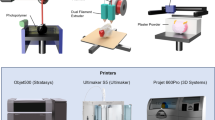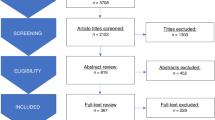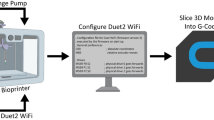Key Points
-
3D printing is a technology that has been used in manufacturing for a few decades and multiple medical fields have adopted this technology for the creation of both inorganic and organic constructs
-
Inkjet printing, extrusion printing, laser sintering, and stereolithography, each with its own advantages and disadvantages, are the four major techniques used for 3D printing
-
3D printers were previously expensive, but new models can now be purchased from ∼US$300; the printing times can be highly variable depending on the desired resolution of the construct
-
In urology, 3D printing is currently being applied to create implantable devices such as ureteral stents, as well as inorganic models for surgical planning
-
Animal studies are already underway for the creation of 3D organic constructs that are intended to replace vital organs, including the bladder, kidneys, and urethra
-
The goal of bioprinting 3D organic constructs is to provide a personalized solution for organ replacement, alleviating the shortage of suitable transplant organs and associated complications
Abstract
3D printing is an evolving technology that enables the creation of unique organic and inorganic structures with high precision. In urology, the technology has demonstrated potential uses in both patient and clinician education as well as in clinical practice. The four major techniques used for 3D printing are inkjet printing, extrusion printing, laser sintering, and stereolithography. Each of these techniques can be applied to the production of models for education and surgical planning, prosthetic construction, and tissue bioengineering. Bioengineering is potentially the most important application of 3D printing, as the ability to produce functional organic constructs might, in the future, enable urologists to replicate and replace abnormal tissues with neo-organs, improving patient survival and quality of life.
This is a preview of subscription content, access via your institution
Access options
Access Nature and 54 other Nature Portfolio journals
Get Nature+, our best-value online-access subscription
$29.99 / 30 days
cancel any time
Subscribe to this journal
Receive 12 print issues and online access
$209.00 per year
only $17.42 per issue
Buy this article
- Purchase on Springer Link
- Instant access to full article PDF
Prices may be subject to local taxes which are calculated during checkout



Similar content being viewed by others
References
Ford, H. & Crowther, S. My life and work. (Doubleday, 1923).
Hull, C. W. Apparatus for production of three-dimensional objects by stereolithography. US Patent 4575330 (1986).
Myung, D., Jais, A., He, L., Blumenkranz, M. S. & Chang, R. T. 3D printed smartphone indirect lens adapter for rapid, high quality retinal imaging. J. Mob. Technol. Med. 3, 9–15 (2014).
Otsuki, B. et al. Developing a novel custom cutting guide for curved peri-acetabular osteotomy. Int. Orthop. 37, 1033–1038 (2013).
Alberti, C. Three-dimensional CT and structure models. Br. J. Radiol. 53, 261–262 (1980).
Aldinger, G., Fischer, A. & Kurtz, B. Computer-aided manufacture of individual endoprostheses. Preliminary communication. Arch. Orthop. Trauma. Surg. 102, 31–35 (1983).
Atalay, H. A. et al. Impact of three-dimensional-printed pelvicalyceal system models on residents' understanding of pelvicalyceal system anatomy before percutaneous nephrolithotripsy surgery: a pilot study. J. Endourol. 30, 1132–1137 (2016).
Salmi, M. Possibilities of preoperative medical models made by 3D printing or additive manufacturing. J. Med. Eng. 2016, 6191526 (2016).
Skardal, A. & Atala, A. Biomaterials for integration with 3D bioprinting. Ann. Biomed. Eng. 43, 730–746 (2015).
Murphy, S. V. & Atala, A. 3D bioprinting of tissues and organs. Nat. Biotechnol. 32, 773–785 (2014).
Guillotin, B. & Guillemot, F. Cell patterning technologies for organotypic tissue fabrication. Trends Biotechnol. 29, 183–190 (2011).
Hölzl, K. et al. Bioink properties before, during and after 3D bioprinting. Biofabrication 8, 032002 (2016).
Xu, T. et al. Viability and electrophysiology of neural cell structures generated by the inkjet printing method. Biomaterials 27, 3580–3588 (2006).
Goldstein, T. A. et al. Feasibility of bioprinting with a modified desktop 3D printer. Tissue Eng. Part C Methods 22, 1071–1076 (2016).
Graham, A. D. et al. High-resolution patterned cellular constructs by droplet-based 3D printing. Sci. Rep. 7, 70441 (2017).
Tekin, E., Smith, P. J. & Schubert, U. S. Inkjet printing as a deposition and patterning tool for polymers and inorganic particles. Soft Matter 4, 703–713 (2008).
Fang, Y. et al. Rapid generation of multiplexed cell cocultures using acoustic droplet ejection followed by aqueous two-phase exclusion patterning. Tissue Eng. Part C Methods 18, 647–657 (2012).
Phillippi, J. A. et al. Microenvironments engineered by inkjet bioprinting spatially direct adult stem cells toward muscle- and bone-like subpopulations. Stem Cells 26, 127–134 (2008).
Campbell, P. G., Miller, E. D., Fisher, G. W., Walker, L. M. & Weiss, L. E. Engineered spatial patterns of FGF-2 immobilized on fibrin direct cell organization. Biomaterials 26, 6762–6770 (2005).
Saunders, R. E., Gough, J. E. & Derby, B. Delivery of human fibroblast cells by piezoelectric drop-on-demand inkjet printing. Biomaterials 29, 193–203 (2008).
Chang, C. C., Boland, E. D., Williams, S. K. & Hoying, J. B. Direct-write bioprinting three-dimensional biohybrid systems for future regenerative therapies. J. Biomed. Mater. Res. B Appl. Biomater. 98, 160–170 (2011).
Jakab, K., Damon, B., Neagu, A., Kachurin, A. & Forgacs, G. Three-dimensional tissue constructs built by bioprinting. Biorheology 43, 509–513 (2006).
Chang, R., Nam, J. & Sun, W. Effects of dispensing pressure and nozzle diameter on cell survival from solid freeform fabrication-based direct cell writing. Tissue Eng. Part A 14, 41–48 (2008).
Colina, M., Serra, P., Fernández-Pradas, J. M., Sevilla, L. & Morenza, J. L. DNA deposition through laser induced forward transfer. Biosens. Bioelectron. 20, 1638–1642 (2005).
Dinca, V. et al. Directed three-dimensional patterning of self-assembled peptide fibrils. Nano Lett. 8, 538–543 (2008).
Lin, H. et al. Application of visible light-based projection stereolithography for live cell-scaffold fabrication with designed architecture. Biomaterials 34, 331–339 (2013).
Smith, S. J., Bosniak, M. A., Megibow, A. J., Hulnick, D. H., Horii, S. C. & Raghavendra, B. N. Renal cell carcinoma: earlier discovery and increased detection. Radiology 170, 699–703 (1989).
Srougi, V. et al. The use of three-dimensional printers for partial adrenalectomy: estimating the resection limits. Urology 90, 217–220 (2016).
von Rundstedt, F.-C., Scovell, J. M., Agrawal, S., Zaneveld, J. & Link, R. E. Utility of patient-specific silicone renal models for planning and rehearsal of complex tumour resections prior to robot-assisted laparoscopic partial nephrectomy. BJU Int. 119, 598–604 (2017).
Komai, Y. et al. Patient-specific 3-dimensional printed kidney designed for 4D surgical navigation: a novel aid to facilitate minimally invasive off-clamp partial nephrectomy in complex tumor cases. Urology 91, 226–232 (2016).
Shin, T., Ukimura, O. & Gill, I. S. Three-dimensional printed model of prostate anatomy and targeted biopsy-proven index tumor to facilitate nerve-sparing prostatectomy. Eur. Urol. 69, 377–379 (2016).
Knoedler, M. et al. Individualized physical 3-dimensional kidney tumor models constructed from 3-dimensional printers result in improved trainee anatomic understanding. Urology 85, 1257–1261 (2015).
Bernhard, J. C. et al. Personalized 3D printed model of kidney and tumor anatomy: a useful tool for patient education. World J. Urol. 34, 337–345 (2016).
Smektala, T., Golab, A., Królikowski, M. & Slojewski, M. Low cost silicone renal replicas for surgical training - technical note. Arch. Esp. Urol. 69, 434–436 (2016).
Bücking, T. M. et al. From medical imaging data to 3D printed anatomical models. PLOS One 12, e0178540 (2017).
Ebert, J. et al. Direct inkjet printing of dental prostheses made of zirconia. J. Dent. Res. 88, 673–676 (2009).
Li, J., Hsu, Y., Luo, E., Khadka, A. & Hu, J. Computer-aided design and manufacturing and rapid prototyped nanoscale hydroxyapatite/polyamide (n-HA/PA) construction for condylar defect caused by mandibular angle ostectomy. Aesthet. Plast. Surg. 35, 636–640 (2011).
Turgut, G., Sacak, B., Kiran, K. & Bas, L. Use of rapid prototyping in prosthetic auricular restoration. J. Craniofac. Surg. 20, 321–325 (2009).
Lu, S. et al. A novel computer-assisted drill guide template for lumbar pedicle screw placement: a cadaveric and clinical study. Int. J. Med. Robot. 5, 184–191 (2009).
Park, C.-J. et al. Anti-Reflux Ureteral Stent with Polymeric Flap Valve Using Three-Dimensional Printing: An In Vitro Study. J. Endourol. 29, 1–6 (2015).
del Junco, M. et al. Development and initial porcine and cadaver experience with three-dimensional printing of endoscopic and laparoscopic equipment. J. Endourol. 29, 58–62 (2015).
Neches, R. Y., Flynn, K. J., Zaman, L., Tung, E. & Pudlo, N. On the intrinsic sterility of 3D printing. PeerJ 4, e2661 (2016).
Rankin, T. M. et al. 3D printing surgical instruments: are we there yet? J. Surg. Res. 189, 193–197 (2014).
Colaco, M. & Atala, A. in The Future of Transplant Surgery and Biology Ch. 12.12 (Decker Publishing, 2014).
Spiller, K. L., Maher, S. A. & Lowman, A. M. Hydrogels for the repair of articular cartilage defects. Tissue Eng. Part B Rev. 17, 281–299 (2011).
Li, Z. & Kawashita, M. Current progress in inorganic artificial biomaterials. J. Artif. Organs 14, 163–170 (2011).
Zhang, K. et al. 3D bioprinting of urethra with PCL/PLCL blend and dual autologous cells in fibrin hydrogel: an in vitro evaluation of biomimetic mechanical property and cell growth environment. Acta Biomater. 50, 154–164 (2017).
US National Library of Medicine. ClinicalTrials.gov. Safety and efficacy study of autologous engineered skin substitute to treat partial- and full-thickness burn wounds. https://clinicaltrials.gov/ct2/show/NCT01655407. (2016).
Raya-Rivera, A. et al. Tissue-engineered autologous urethras for patients who need reconstruction: an observational study. Lancet 377, 1175–1182 (2011).
Raya-Rivera, A. M. et al. Tissue-engineered autologous vaginal organs in patients: a pilot cohort study. Lancet 384, 329–336 (2014).
Kang, H.-W. et al. A 3D bioprinting system to produce human-scale tissue constructs with structural integrity. Nat. Biotechnol. 34, 312–319 (2016).
Author information
Authors and Affiliations
Contributions
All authors researched data for the article, made substantial contributions to discussion of the article content, wrote, and reviewed and/or edited the manuscript before submission.
Corresponding author
Ethics declarations
Competing interests
The authors declare no competing financial interests.
Rights and permissions
About this article
Cite this article
Colaco, M., Igel, D. & Atala, A. The potential of 3D printing in urological research and patient care. Nat Rev Urol 15, 213–221 (2018). https://doi.org/10.1038/nrurol.2018.6
Published:
Issue Date:
DOI: https://doi.org/10.1038/nrurol.2018.6
This article is cited by
-
Three-dimensional printing versus conventional machining in the creation of a meatal urethral dilator: development and mechanical testing
BioMedical Engineering OnLine (2020)
-
Towards clinical application of tissue engineering for erectile penile regeneration
Nature Reviews Urology (2019)
-
Bildgebung in der individualisierten Uroonkologie
Der Urologe (2018)



